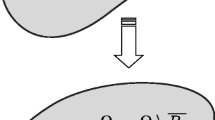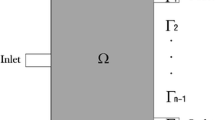Abstract
This paper describes a topology design method for simple two-dimensional flow problems. We consider steady, incompressible laminar viscous flows at low-to-moderate Reynolds numbers. This makes the flow problem nonlinear and hence a nontrivial extension of the work of Borrvall and Petersson (2003).Further, the inclusion of inertia effects significantly alters the physics, enabling solutions of new classes of optimization problems, such as velocity-driven switches, that are not addressed by the earlier method. Specifically, we determine optimal layouts of channel flows that extremize a cost function which measures either some local aspect of the velocity field or a global quantity, such as the rate of energy dissipation. We use the finite element method to model the flow, and we solve the optimization problem with a gradient-based math-programming algorithm that is driven by analytical sensitivities. Our target application is optimal layout design of channels in fluid network systems. Using concepts borrowed from topology optimization of compliant mechanisms in solid mechanics, we introduce a method for the synthesis of fluidic components, such as switches, diodes, etc.
Similar content being viewed by others
References
AnaKotKik94 Ananthasuresh GK, Kota S, Kikuchi N (1994) Strategies for systematic synthesis of compliant MEMS. Dyn Syst Control 2:677-686
BA01 Beebe DJ, Adrian RJ et al. (2001) Passive mixing in microchannels: Fabrication and flow experiments. Mec Ind 2:343–348
BenKik88 Bendsøe MP, Kikuchi N (1988) Generating optimal topologies in structural design using a homogenization method. Comput Methods Appl Mech Eng 71(2):197–224
BenSig99 Bendsøe MP, Sigmund O (1999) Material interpolation schemes in topology optimization. Arch Appl Mech 69(9–10):635–654
BENSIG04 Bendsøe MP, Sigmund O (2004) Topology optimization—theory, methods, and applications. Springer, Berlin Heidelberg New York
BORPET02 Borrvall T, Petersson J (2003) Topology optimization of fluids in Stokes flow. Int J Numer Methods Fluids 41:77–107
BruSigTor02 Bruns TE, Sigmund O, Tortorelli DA (2002) Numerical methods for the topology optimization of structures that exhibit snap-through. Int J Numer Methods Eng 55:1215–1237
FEMLABman COMSOL: FEMLAB Reference Manual for FEMLAB 2.3. COMSOL AB, Stockholm, www.comsol.se
Currie Currie IG (2003) Fundamental mechanics of fluids. 3rd edn, Marcel Dekker, New York
DG96 Gartling DK, Hickox CE, Givler RC (1996) Simulation of coupled viscous and porous flow problems. Comput Fluid Dyn 7:23–48
AGH03 Gersborg-Hansen A (2003) Topology optimization of incompressible Newtonian flows at moderate Reynolds numbers. Master’s Thesis, Technical University of Denmark. Department of Mechanical Engineering Solid Mechanics, Lyngby
GloPir Glowinski R, Pironneau O (1975) On the numerical computation of the minimum-drag profile in laminar flow. J Fluid Mech 72:385–389
Helbo Helbo B, Kristensen A, Menon A (2003) A micro-cavity fluidic dye laser. J Micromech Microeng 13(2):307–311
HorKocWer01 Hörnlein HREM, Kocvara M, Werner R (2001) Material optimization: bridging the gap between conceptual and preliminary design. Aerosp Sci Technol 5(8):541–554
JenSig04 Jensen JS, Sigmund O (2004) Systematic design of photonic crystal structures using topology optimization: Low-loss waveguide bends. Appl Phy Lett 84(12):2022–2024
LunMolJak03 Lund E, Møller H, Jakobsen LA (2003) Shape design optimization of stationary fluid–structure interaction problems with large displacements and turbulence. Struct Multidisc Optim 25(5–6):383–392
MICTORVID94 Michaleris P, Tortorelli DA, Vidal C (1994) Tangent operators and design sensitivity formulations for transient non-linear coupled problems with applications in elastoplasticity. Int J Numer Methods Eng 37(14):2471–2499
MohPir01 Mohammadi B, Pironneau O (2001) Applied shape optimization for fluids. Oxford University, Oxford
Panton Panton RL (1996) Incompressible flow. Wiley, New York
PedBuhSig01 Pedersen CBW, Buhl T, Sigmund O (2001) Topology synthesis of large-displacement compliant mechanisms. Int J Numer Methods Eng 50(12):2683–2705
Ped01-02 Pedersen NL (2001) On topology optimization of plates with prestress. Int J Numer Methods Eng 51(2):225–240
Pir1 Pironneau O (1974) On optimum design in fluid mechanics. J Fluid Mech 64:97–110
Reddy Reddy JN, Gartling DK (2001) The finite element method in heat transfer and fluid dynamics, 2nd edn, CRC Press LLC, Boca Raton, Florida
Sig97 Sigmund O (1997) On the design of compliant mechanisms using topology optimization. Mech Struct Machines 25(4):495–526
Sig00 Sigmund O (2000) A new class of extremal composites. J Mech Phys Solid 48(2)397–428
Sig01-01 Sigmund O (2001a) A 99 line topology optimization code written in MATLAB. Struct Multidisc Optim 21:120–127
Sig01-02 Sigmund O (2001b) Design of multiphysics actuators using topology optimization—Part I: one-material structures. Comput Methods Appl Mech Eng 190(49–50):6577–6604
Sig01-03 Sigmund O (2001c) Design of multiphysics actuators using topology optimization—Part II: two-material structures. Comput Methods Appl Mech Eng 190(49–50):6605–6627
SIGGERHAB03 Sigmund O, Gersborg-Hansen A, Haber RB (2003) Topology optimization for multiphysics problems: a future femlab application? In: Gregersen L (ed) Nordic Matlab Conference (held in Copenhagen), pp 237–242, Søborg, Denmark
SigJen03 Sigmund O, Jensen JS (2003) Systematic design of phononic band gap materials and structures by topology optimization. Philos Trans R Soc A: Math Phys Eng Sci 361:1001–1019
StrDerAjd02 Stroock AD, Dertinger SKW, Ajdari A et al. (2002) Chaotic mixer for microchannels. Science 295:647–651
Sva87 Svanberg K (1987) The method of moving asymptotes—a new method for structural optimization. Int J Numer Methods Eng 24:359–373
VIDLEEHAB91 Vidal CA, Lee HS, Haber RB (1991) The consistent tangent operator for design sensitivity analysis of history-dependent response. Comput Sys Eng 2:509–523
YanChaSot00 Yang RJ, Chuang C-H, Che X, Soto CA (2000) New applications of topology optimization in automotive industry. Int J Vehicle Des 23(1):1–15
ZieTay00 Zienkiewicz OC, Taylor RL (2000) The Finite Element Method (Parts 1–3). Butterworth Heinemann, Oxford
ZhoRoz91 Zhou M, Rozvany GIN (1991) The COC algorithm, part II: topological, geometry and generalized shape optimization. Comput Methods Appl Mech Eng 89:197–224
Author information
Authors and Affiliations
Corresponding author
Rights and permissions
About this article
Cite this article
Gersborg-Hansen, A., Sigmund, O. & Haber, R. Topology optimization of channel flow problems. Struct Multidisc Optim 30, 181–192 (2005). https://doi.org/10.1007/s00158-004-0508-7
Received:
Revised:
Published:
Issue Date:
DOI: https://doi.org/10.1007/s00158-004-0508-7




